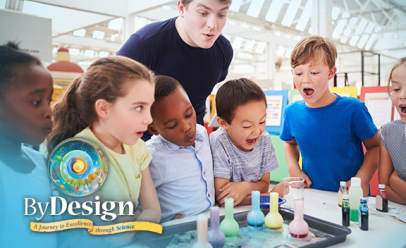 By: Kendall Hunt RPD with contributions from the editorial team
By: Kendall Hunt RPD with contributions from the editorial team
For one school, it’s all part of the culture of “surprise and delight.”
In Eminence, Kentucky, the cafeteria slide is just one feature of the EDHub, a 30,000-square-foot technology-based space at the heart of the school. This space includes unconventional seating, eight “maker” labs, and open areas with large windows. Students have access to a variety of twenty-first-century technologies, from virtual reality to 3-D printers.
They collaborate on community service projects, such as the hoverboard wheelchair built by a fifth-grade class for their classmates. Through the “surprise and delight” approach to learning, students are continually engaged with new and unique ideas.
And it works. In the Eminence school district, where only 20% of students pursued post-secondary education, now 100% of students achieve college and career readiness according to Kentucky state standards. Graduation rates and college persistence rates have significantly increased, and enrollment has doubled.
But what about those of us without access to such state-of-the-art educational spaces? What is the relevance of “surprise and delight”? Eminence superintendent Buddy Berry sums it up perfectly, “The building’s awesome, but it’s what’s happening inside … that’s really special.” In other words, you don’t need a fancy building to implement “surprise and delight” in your classroom. It’s all about presenting information in new and unique ways.
“Surprise and delight” learning effectively works with our brains to be drawn to the new and unique ideas or themes presented. Whether it’s an unconventional project, a virtual reality field trip, or a Zoom session with an author, presenting content in novel ways triggers new synapses to fire in our brains and forge new educational pathways. This strengthens neural connections, making us more receptive to learning new information. Psychologically, “surprise and delight” learning keeps students engaged because they are always curious about what creative idea their teacher will come up with next. Physiologically, constantly learning in new ways keeps students’ brains active and ready to absorb more information.
The essence of “surprise and delight” is driving learning that goes beyond the traditional desk and textbook. It’s about keeping learning fresh and interesting, learning by doing, and allowing students to choose what they study and how they do it. This approach doesn’t require an EDHub; it’s something anyone can do because “surprise and delight” is essentially inquiry learning.
Our ByDesign Science program is deeply rooted in inquiry science, enabling teachers to “surprise and delight” students with innovative and engaging activities. Through experiments, Explore-a-Lab features, and open inquiries, students explore material in various ways in each unit or chapter. They might design their own wellness plan, test the strength of different materials, or learn to care for animals. By varying the learning methods and keeping students surprised with different approaches, ByDesign fosters student curiosity and innovation, preparing them to learn more as they progress through our program for grades 1–8.
Our partnership with VictoryVR also provides Kendall Hunt Religious Publishing with another “surprise and delight” option for students. Experiencing content through a virtual reality (VR) lens offers students a different way to learn and sparks their curiosity (and their synapses). With 48 virtual field trips, including journeys to outer space and the human cell, this cutting-edge technology is at the forefront of inquiry learning.
“We want kids to think differently and become creative, so ‘surprise and delight’ triggers new ideas for everyone,” said Berry. Discover how our ByDesign Science program achieves this with our student-led, inquiry-based curriculum.
What classroom projects have “surprised and delighted” your students … or yourself?
Sources:
https://www.edutopia.org/video/cranking-teaching-strategies-awesome
https://www.edutopia.org/video/building-21st-century-learning-space\
https://www.edutopia.org/video/building-empathy-through-community-projects